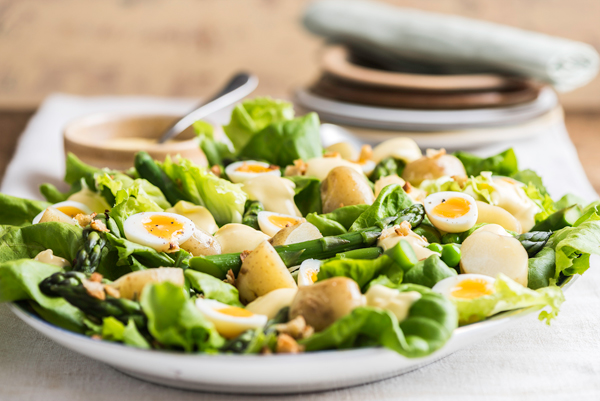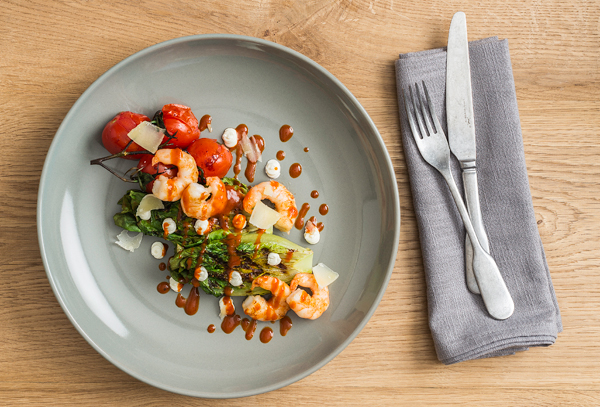Home-grown harvest: lettuce
Although ubiquitous served raw in salads, lettuce can also be cooked and served in myriad ways, with different leaves offering a variety of flavour profiles from sweet to peppery. Russell Brown investigates
Defining the term ‘lettuce' is a difficult one. The dictionary will give you variations of ‘a plant with large green leaves eaten uncooked in salads', but lettuce is usually used as a catch-all name for most salad leaves, be they whole heads, baby leaves, bunches of watercress or heads of chicory.
The fact that cooks give the name lettuce to such a wide range of plants makes talking about the seasonality difficult, but a number of different leaves, such as Batavia, Cos (or Romaine), oak leaf, butterhead, round lettuce, Lollo Rosso and escarole all crop outdoors in the UK between May and October. The number of different varieties and types of lettuce is huge, and a quick flick through a seed catalogue or a browse online will throw up several dozen choices. Given that the freshness of salad leaves is key, this really is a great option for the kitchen garden.
Large growers such as the Watercress Company (who have farms in Dorset, Hampshire, Spain and the US) grow around 14 kinds of salad leaves, including several types of lettuce. Here it is an exclusively outdoor crop, which leads to more robust leaves. Ross Geach at Padstow Kitchen Garden grows mainly a mix of mizuna and pak choi for restaurants, although client Rick Stein's restaurants have switched back to more old-school varieties, such as Batavia, Lollo Rosso and oak leaf. The UK climate, particularly in coastal regions, is well suited to lettuce growing as temperatures don't get too high.
The flavour profiles and textures of lettuce are hugely varied, and soft, crunchy, waxy, sweet, peppery, bitter or hot can all be used to describe the leaves. This is perhaps why a really good mixed leaf salad that has been carefully dressed and seasoned can be such a triumph despite its apparent simplicity. It is the blending of all the flavours and textures that takes the skill.
Lettuce is most widely used raw in salads; a classic English salad would be soft butterhead lettuce, tomato, cucumber, hard-boiled eggs and possibly chunks of Cheddar cheese, dressed with salad cream. This dish has seen something of a revival in recent years, having previously been usurped by the likes of rocket and sun-dried tomato or frisée with lardons and poached eggs. The dish has a number of variations and has been brought to new heights of sophistication with home-made salad creams and carefully selected ingredients. The salad really has gone through a number of fashions in the past few decades.
Whether lettuce is served cold, in warm salads or cooked, chefs have shown huge imagination in the way that the different leaves are utilised. Examples include: soups, veloutés, braised with peas and bacon, encasing spicy pulled pork, combined with avocado, bacon and a creamy dressing or tossed with strips of warm, rare sirloin. Bitter leaves can balance sweetness, cheeses can add richness and the lettuce can provide varying textures. I have seen lettuce dressings, fish cooked in lettuce leaves and compact heads heavily charred on a barbecue. The variations on classics, such as a Caesar salad or a Niçoise, are myriad.
Chef Olivier Certain, who has recently joined the team at the Swan in Bampton, Devon, likes Little Gem for braising and serving with lamb and also favours it in a classic peas à la Française. At the Michelin-starred the Pony & Trap in Chew Magna, Bristol, chef-proprietor Josh Eggleton uses large leaf salads with thin sourdough croûtes and a homemade salad cream in the bottom of the dish to create a simple starter that showcases the bold flavours of the leaves. The dish is enhanced with baby radishes from the garden, a classic vinaigrette and a couple of spears of chargrilled asparagus.
Market report
Heads of Lollo Rosso, Oak Leaf and Biondi from Dorset are coming in at around 95p per head, while frisée is currently £1.40
Kris Hall, Country Fare
www.countryfare.co.uk
Buying and storage
• Lettuce, particularly whole heads, should be chilled as quickly as possible after harvesting
• Keep lettuce at a cool temperature, between 3°C and 5°C
• Lettuce can be stored as whole heads in loose plastic bags or as washed and dried leaves in sealed tubs
• Shelf life will be between two and five days depending on how robust the variety is
• Soaking lettuce in iced water will crisp up wilted leaves
English garden salad with homemade salad cream
Serves 4
For the salad cream
2 hard-boiled egg yolks
30ml cider vinegar
30ml lemon juice
1tsp caster sugar
1tsp Dijon mustard
½tsp English mustard powder
100ml double cream
75ml rapeseed oil
Maldon sea salt and freshly ground black pepper
For the salad
1 head of soft lettuce
12 spears of asparagus, trimmed and blanched
100g fresh peas, blanched
12 soft-boiled quail eggs
12 cooked baby new potatoes, halved
50g Old Winchester cheese, shaved (optional)
To serve
50g coarse fried breadcrumbs
Place the egg yolks, vinegar, lemon juice, sugar and mustards in a small blender and mix to a smooth purée. Add the cream and blend until the cream starts to thicken. Gradually add the oil and blend until emulsified. Season to taste. Do not overmix as the cream can split.
Make sure all the ingredients for the salad are at room temperature. Assemble on individual serving plates or a large platter. Spoon on the salad cream and scatter the fried crumbs over the dish. Serve any remaining salad cream on the side.
Warm salad of chargrilled Gem lettuce, roasted tomatoes, tiger prawns and chilli dressing
Serves 4
For the dressing
100ml tomato passata
5g Dijon mustard
20g runny honey
1 medium red chilli, skinned and deseeded
30ml good quality sherry vinegar
1 clove garlic, skinned and soaked in boiling water for five minutes
50ml light olive oil
Maldon sea salt and freshly ground black pepper
For the lettuce
4 heads of Little Gem, trimmed and halved lengthwise
30ml olive oil
Maldon sea salt and freshly ground black pepper
For the tomatoes
12-16 cherry tomatoes on the vine
20ml olive oil
20ml good quality sherry vinegar
Maldon sea salt and freshly ground black pepper
For the prawns
20 large raw prawns
30ml olive oil
20g unsalted butter
Maldon sea salt and freshly ground black pepper
To serve
50g seasoned mascarpone
Parmesan shavings
To make the dressing, combine all the ingredients (except the seasoning) in a blender and blitz until smooth. Season to taste. Adjust with more vinegar/honey if required.
Pour the oil for the lettuce onto a tray or plate and add seasoning, then rub the cut surfaces of the lettuce in the seasoned oil. Heat a chargrill pan over a medium heat and lay the lettuce on, cut-side down. Press down firmly and cook until well marked. Turn and cover with a lid to create a little steam to soften the lettuce. Set to one side to keep warm.
Place the tomatoes in a small roasting tin, drizzle with the oil and vinegar, season and roast in hot oven for four to five minutes.
Heat the olive oil for the prawns in a non-stick frying pan and then season the prawns. Fry over a high heat until they turn pink and are lightly coloured on one side. Flip the prawns over, add the butter and cook for a further 30 seconds until just cooked through. Drain on paper towel.
To serve, place the lettuce charred side up in shallow bowls. Place the tomatoes to one side and then add dots of dressing and mascarpone to the lettuce. Add the prawns to the dish and finish with a few Parmesan shavings.
Coming soon
Over the next few months I will be featuring raspberries and globe artichokes in Home-grown Harvest. Do let me know how you use these products on your menus and what your seasonal favourites are.
Email recipes, dish suggestions and photographs to: russell@creativeaboutcuisine.com




















